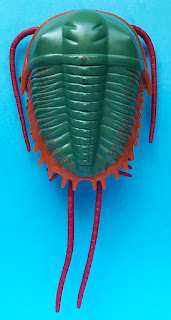Three views (top, bottom, and side) of a plastic model of a Cambrian trilobite (12 cm length). The mineralized "shell" is green, the numerous legs and antennae are red, and the gills (located on top of the legs) are white.
An actual specimen of a representative trilobite (28 mm length) is shown above. The left eye is better preserved that the right eye, which was "smoothed over" by weathering. This specimen, which is slightly curved, appears to show the initial stage of enrollment (curling up).
 Some trilobites are found enrolled. That is to say, their mineralized exoskeletons rolled up (partially or completely), much like modern pill bugs do. Enrollment was the way for
Some trilobites are found enrolled. That is to say, their mineralized exoskeletons rolled up (partially or completely), much like modern pill bugs do. Enrollment was the way fortrilobites to protect their legs, soft undersides, and antennae from predators.
The ability to enroll developed during early, as a few Cambrian forms have been found preserved this way. It became common in the Ordovician, Silurian, and Devonian but was not acquired by all genera.

Calymene meeki (enrolled state), Ordovician, Ohio. 15 mm width.
Some trilobites could "tuck" the end of their pygidium under the edge of the cephalon, thereby allowing more resistance to being pried apart by a predator. On the image on the right, you can see how the edge of the cephalon is indented to accommodate the projected end of the pygidium.





No comments:
Post a Comment